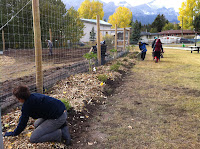Rob Avis from Verge Permaculture refers to many weeds and so-called 'invasive species' as Hard-Working Immigrants...A neat perspective giving value to the many plants dismissed by most gardeners as a nuisance.
Below is some information I came across on
Plants for a Future facebook page that I thought would help us to understand why dandelions and chickweed aren't necessarily a problem in our gardens:
Chickweed - Stellaria media. A very common garden weed, chickweed grows, flowers and sets seed all year round. An annual plant growing about 15cm it spreads by means of seeds. It is very easy to control by hoeing and we actively encourage this plant since it has so many beneficial uses. The young leaves have a mild flavour and can be available all year round if the winter is not too severe. Very nutritious, they can be eaten raw in mixed salads, or cooked to make a very acceptable spinach substitute. The small seed can be ground into a powder and used in making bread or to thicken soups. Chickweed has a very long history of herbal use, being particularly beneficial in the external treatment of any kind of itching skin condition. It has been known to soothe severe itchiness even where all other remedies
have failed. When applied as a poultice, it will relieve any kind of roseola and is effective wherever there are fragile superficial veins. An infusion of the fresh or dried herb can be added to the bath water and its emollient property will help to reduce inflammation - in rheumatic joints for example - and encourage tissue repair.
Dandelion - Taraxacum officinale. Dandelions are another of those weeds that is at times cultivated for its edible leaves - indeed there are a number of named varieties that have been developed in Europe. A perennial plant growing up to 40cm tall, we encourage it in the lawn but tend to discourage it in cultivated beds because slugs like to hide under the leaves. The plant spreads very freely by means of its light seeds, but is easily controlled by hoeing. The leaves are literally packed full of vitamins and minerals, making this one of the most nutritious leaves you can eat. Unfortunately, they have a rather bitter flavour, though we find a few of the leaves added to a mixed salad to be quite acceptable. The bitter tasting root can also be cooked, some people say they have a turnip-like flavour. When roasted and ground into a powder, they can be used as a much healthier alternative to coffee. The dandelion is a commonly used herbal remedy. It is especially effective and valuable as a diuretic because it contains high levels of potassium salts and therefore can replace the potassium that is lost from the body when diuretics are used. The latex contained in the plant sap can be used to remove corns, warts and verrucae. The latex has a specific action on inflammations of the gall bladder and is also believed to remove stones in the liver.
Plantain - Plantago major.
Common Plantain is a common lawn weed. This perennial plant grows up to 20cm tall, though it will be much lower when growing in a frequently cut lawn. Although most gardeners mercilessly root it out of their lawns, it actually does no harm when growing there and, indeed, helps to maintain the fertility of the lawn. The young leaves are rather bitter and tedious to prepare because the fibrous strands need to be removed before use, but they have been used as a pot herb. It is best not to use the leaf-stalk since this is even more fibrous than the leaf. They can be blanched in boiling water before using them in salads in order to make them more tender. Although very tedious to harvest, the seed can be ground into a meal and mixed with flour when making bread, cakes etc. The whole seed can also be boiled and used like sago. Common plantain is a safe and effective medicinal herb. The leaves are used externally as a healing poultice and treatment for bleeding, quickly staunching blood flow
and encouraging the repair of damaged tissue. Internally, they are used in the treatment of a wide
range of complaints including diarrhoea, gastritis, peptic ulcers, irritable bowel syndrome, haemorrhage, haemorrhoids, cystitis, bronchitis, catarrh, sinusitis, asthma and hay fever. Plantain seed husks are an excellent treatment for digestive disorders. They contain up to 30% mucilage which swells up in the gut, acting as a bulk laxative and soothing irritated membranes.
Thistle - Cirsium species. There are many different species of thistle, the two you are most likely to encounter as weeds are C.
arvense, the Creeping Thistle a perennial plant growing to about 90cm, and C. vulgare, the Common
Thistle which is biennial and grows up to 2 metres tall. These are very aggressive weeds, the first spreading freely by means of its roots and the other sending its seeds far and wide to grow where you least expect them. The young roots of both species can be eaten raw or cooked. Although nutritious, they are rather bland with a taste reminiscent of Jerusalem artichokes. They are probably best when used in a mixture with other vegetables. Be warned though, just like Jerusalem artichokes the root is rich in inulin, a starch that cannot be digested by humans. This starch thus passes straight through the digestive system and, in some people, ferments to produce flatulence. The young stems can be peeled and cooked like asparagus or rhubarb. Young leaves have a fairly bland flavour and can also be eaten raw or cooked, but the prickles need to be removebe eaten - not only is this rather fiddly but very little edible leaf remains.




































 then hand dug.....
then hand dug.....
 and fastened...
and fastened... trench back-filled and carefully tidied!
trench back-filled and carefully tidied!







